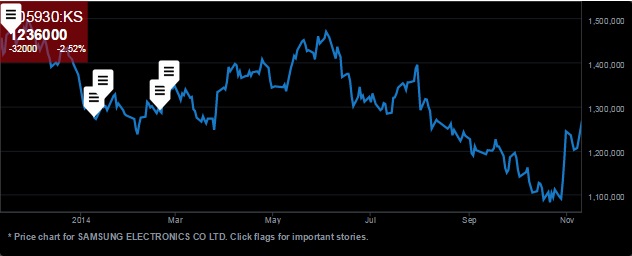Bloomberg: Jets Depart Saigon Belly Full as Samsung Spurs Cargo Boom
11 Nov 2014
- By John Boudreau and Mai Ngoc Chau Nov 11, 2014 12:00 AM GMT+0700
On a rainy Ho Chi Minh City night, a half dozen ground handlers in reflective vests grunt and yell as they jockey an aluminum container onto the main deck of an Airbus A320 cargo jet bound for Hong Kong.
“Look at this container — packed full,” George Berczely, general director of DHL-VNPT Express Ltd. in Vietnam, said in late October as he stood in the cargo hold filling up with electronics, designer clothes and glassware at the airport in former Saigon. “This symbolizes the rest of trade in Vietnam. We are going to have a good fourth quarter.”
DHL-VNPT is enjoying a boom in air freight in Vietnam, where one of the world’s fastest growth rates in airborne shipments is luring the region’s biggest cargo airlines, including Cathay Pacific Airways Ltd. and Korean Air Lines Co. The surge heralds a new phase for the Southeast Asian nation’s exports, as manufacturers from Samsung Electronics Co. to local garment makers producing Calvin Klein Inc. clothes boost the country’s presence in the global supply chain.
Exports are leading a gradual acceleration in Vietnam’s economy, a counterpoint to the struggles of the banking industry and state-owned enterprises whose bad debts have damped domestic spending in recent years. The country has become the leading Southeast Asian exporter to the U.S., and shipments there may jump 19 percent to about $29 billion this year, according to the American Chamber of Commerce in Vietnam.
Manufacturing
“Vietnam is increasingly export-dependent,” said Trinh Nguyen, a Hong Kong-based economist at HSBC Holdings Plc. “We forecast that exports will be about 80 percent of gross domestic product this year. The manufacturing sector continues to grow.”
Total exports rose 13.4 percent from a year earlier to $123 billion in the 10 months through October. Telephones and parts, the country’s biggest-selling products at 16 percent of total shipments, gained 6.9 percent, while bags, wallets and apparel jumped 36 percent.
Much of that gain is happening by air. In 2013, local airports processed 770,000 metric tons of goods, a 67 percent leap from 2010, according to data from the Civil Aviation Authority of Vietnam. Air cargo is forecast to jump 23 percent in 2014, according to the transport ministry.
“In the last couple of years we have seen that Vietnam is the out-performer in Southeast Asia for air exports,” said Marco Bloemen, senior vice president at air cargo and logistics consulting firm Seabury Cargo Advisory in Amsterdam. The country’s air-cargo market will have “strong growth” in the coming years, he said.
Mobile Phones
Demand for air cargo is coming from companies such as Suwon, South Korea-based Samsung, LG Electronics Inc. , Apple Inc. supplier Wintek Corp. and Intel Inc., whose electronics goods made in Vietnam need the speedy service by plane.
Reflecting the depth of that demand, Samsung will operate its own terminal at Hanoi’s Noi Bai International Airport in late 2015, said Vo Huy Cuong, deputy head of the Civil Aviation Authority of Vietnam.
DHL-VNPT, a unit of DHL Express, opened a $10 million shipping facility at Ho Chi Minh City’s Tan Son Nhat International Airport this year to meet demand in one of the company’s fastest-rising Asian markets, Berczely said. Its operations sit between those run by UPS and FedEx Corp. (FDX) at the airport.
Airlines are also responding. Taoyuan, Taiwan-based EVA Airways Corp. has increased its weekly cargo flights to Hanoi to three from two in the last two years, said Glenn Chai, the airline’s executive vice president. The company is planning to add a third daily passenger flight between Taipei and Ho Chi Minh City next year that can ferry freight, he said.
Cathay, Korean Air
“We are carrying a lot electronics goods in and out of Vietnam,” Chai said. “There is a lot of competition from other carriers. They are like sharks. They smell blood.”
Cathay said in August that it plans to add services to manufacturing hubs in inland China, Vietnam and Mexico. Korean Air is looking to expand in emerging markets such as China, Vietnam and Latin America, it said earlier this year. Cathay and Korean Air are Asia’s two biggest cargo airlines.
Carrying cargo on passenger jets makes an aviation market more desirable for international carriers, said Tony Tyler, chief executive of the International Air Transport Association, said in an interview in Hanoi in August.
“Having that freight in the belly makes a huge difference to the economics of operating wide-body aircraft,” Tyler said. “This makes Vietnam attractive.”
DHL, FedEx
Every day, DHL and FedEx Corp. trucks pull up to Ho Chi Minh City-based Nha Be Garment Corp., whose customers have included Calvin Klein and Hennes & Mauritz AB. (HMB)
“We ship out 100 samples a day by air to Europe and the U.S.,” Tony Nguyen, senior merchandising manager, said amid the rat-a-tat-tat of sewing machines, billows of steam from clothes presses and the whirl of giant fans. Sometimes the company, which is partially owned by Vietnam National Textile & Garment Group, ships rush orders of creased suits on hangers to boutique shops in Australia and the U.S., he said.
The company’s garments were on board the Hong Kong-bound Airbus cargo plane in Ho Chi Minh City that was operated by a joint venture between DHL and Cathay.
“We are completely full tonight,” Captain Ole Raaen said as the final containers were wedged into the plane’s hold. “More often than not, we are full out of Ho Chi Minh City.”
Bloomberg: Jets Depart Saigon Belly Full As Samsung Spurs Cargo Boom
